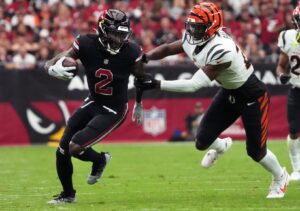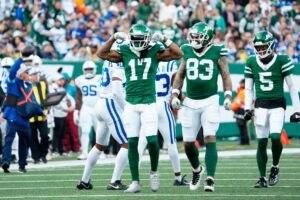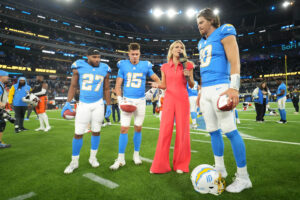Painted in vast array of color, both bright and dull, the Kansas City Chiefs 2017 season was a myriad of frustration. To paint the season as a failure would be dismissing the incredible play of Alex Smith, Kareem Hunt, and Albert Wilson. Failure would dismiss the method Matt Nagy used to repaint the offensive as a beautiful picture when everything was going wrong. At surface level, an AFC West division title at 10-6 is no mere, average wash of a failure. The Chiefs were awe inspiring when they were good, and putrid when bad.
And yet, that putrid taste the team left with the wild card playoff loss to the Tennessee Titans will be what the 2017 Chiefs are remembered for. A more apt adjective than failure would be disappointment. The team left no doubt in successful fronts, but also left no doubt where they were an abject disaster. Fortunately, moving forward there ought to be clear implications for the front office to rework those positions. However, in the moment, those data lines are purely frustrating, reminiscent of that which could have been. The 2017 Kansas City Chiefs stats are poignancy in a data book – a line of fun facts that are fun, but in the end, are meaningless due to the depravity at certain positions.
Here, the focus will be on the offensive side of the football while part two will center on defense and special teams.
2017 Kansas City Chiefs Stats – A Book of Average Fun Facts (Offense)
Alex Smith
Smith completed not only one of his best seasons as a professional, but one of the most efficient seasons an NFL quarterback has ever had. Yes, at the end of the day Smith is beholden to play calling and managerial status, but that nomenclature is not necessarily a bad thing. When both Smith, Hunt, and the rest of the play makers were under the tutelage of proper play calling, they were exhilarating.
Smith finished the season with his first 4,000-yard season, the most touchdowns in his career (26), tied for the fewest interceptions in his career (five), and the highest rating in his career at 104.7. Furthermore, he accomplished this while increasing the range in which he threw, ending in eight yards per attempt (tied for most in his career) and 8.6 adjusted yards per attempt.
Stacking Smith up to the rest of the NFL, he finished eighth in yards, first in passer rating, ninth in touchdowns, and the least amount of interceptions for regularly starting quarterbacks.
Smith’s season, however, was precisely beholden to play-calling. Smith is never going to blow the ball down the field, but he is going to execute a good game plan. Most quarterbacks, save a few heralded legends, are beholden to a good game plan as well.
The first contextualizing point is the deep pass. Smith was deadly precise the few times he did get the call to go deep. There was a pointed difference between those passes which Smith was forced to throw deep, and those he was able to throw deep per a precisely timed play. This season, the rise in statistics was not due to more downfield throws, but better-timed throws down field.
Overall, Smith threw 93 deep passes on the season. Interestingly enough, and pointing to the fact the best of these were designed, 41 deep passes occurred on first down, while only 22 occurred on third down. Of the 93 passes, he completed 47 for 1,633 yards, 13 touchdowns, and only two interceptions for a rating of 126.9 – a phenomenal rate of precision.
The most thrown in one game was 10, against the New York Jets. Four went for touchdowns, but the final forced throws were tragically off target. Ironically, the Chiefs bland defense lost the game when Smith looked like a gunslinger, not a game manager.
Epitomizing the notion Smith does not work well off script is when the deep passes had to be made for a comeback. In the fourth quarter, he attempted 28 deep passes, completing 12. While that is still an average mark, the actual yardage of those deep plays fell to 15.9 with three touchdowns.
Most repugnant was the fact after six minutes remained, none of his deep passes went for touchdowns.
Of course, having the fastest player in the NFL helps – Tyreek Hill caught 15 deep passes for 670 yards while Travis Kelce saw 19 receptions for 478 yards. The pure dominance of those two accounted for 64 targets – where the direction of the game plan was clear.
In 2017, Smith excelled on script, specifically under Nagy’s tutelage, and when off-script was average. In the NFL, that ought to put a team in a quaint, competitive place. And that is where the Chiefs stand: good enough to get to the playoffs on script, but forced to overcome in the clutch of the playoffs, they falter.
Kareem Hunt
Hunt, also known as the NFL’s rushing leader with 1,327 yards, was not only dominant on the ground, but in the air as well, catching 53 passes on an astonishing 84.1% catch rate for 455 yards. Contextualizing his performance with film study and he was a hard-nosed blocker, epitomizing his grit and determination.
As a fun fact, the 84.1 percent catch rate led the league for running backs with over 40 targets. Equally impressive efficiency came from Dion Lewis, catching 32 of 35 targets, Alvin Kamara, 81 of 100 targets, and Todd Gurley, 64 of 87 targets. Hunt caught those passes while averaging the 12th longest route in the NFL, at 7.22 yards per pass.
Hunt was the most pleasant and necessary surprise for the Chiefs this year. His running was so influential to the team’s success, success could not be separated from his name. During the mid-season lull, especially against the Dallas Cowboys, the lack of running was a major concern for the team. The team was far more balanced once Hunt got the ball through the interior of the line – not on silly screen plays.
When the Chiefs ran the ball as a collective unit over 20 times, their record was 9-2, emblematic of how the offensive ecosystem ought to work.
Running Backs
Hunt was not the only running back on the Chiefs roster the entire season. After losing Spencer Ware, the backfield was quickly cut down to a few names: C.J. Spiller, Akeem Hunt, Charcandrick West, and Anthony Sherman.
Unfortunately, none carried a significant statistical line. West only had 18 carries all year long, serving more impact as a receiver, finishing with 27 receptions for 150 yards. However, he did score two rushing and two receiving touchdowns. Not exquisite, but functional enough for a third string back who is efficient in the red zone.
Spiller barely played despite being a member of the team. He only suited up once. However, the coaching staff used him in practice – or something. He was constantly on and off the roster, serving some odd role. He was signed and cut five times, and has yet to be cut since signing in early January.
Sherman barely saw any carries or receptions, and as a fullback that is expected. Still, he is a key member of the team, often found on tape paving the way for Hunt or smashing some player on special teams. However, he was featured in the last game of the season against the Denver Broncos, netting 14 interior carries for 40 yards and a touchdown. So, the smash mouth potential does exist.
Travis Kelce
There was no doubt who Smith would go to time and time again to break apart defenses – Travis Kelce. Just past the halfway point, Kelce was on course to smash a career high in receptions, yards, and touchdowns. Yet, the season concluded with a career high in targets (122) and just shy of a high in reception (83, needed to obtain 86). After the Pittsburgh Steelers showed that a cover two scheme could usurp the Chiefs most successful routes, other teams began to copy that coverage and thus negate Kelce.
Stats do not always tell the importance of a player to a team; Kelce caught eight crucial touchdowns, and as discussed before, was essential to the deep ball precision. The impact of Kelce was felt in specific games. He only saw less than five targets twice (four against the Buffalo Bills, one in the first battle against the Los Angeles Chargers). Even when not beating opponents for receptions, his ability as a physical tight end makes him a prominent distraction for the secondary – both Albert Wilson and Tyreek Hill received higher than average targets in those two games.
Justifying which was Kelce’s best game is a difficult task. Albeit, the first matchup against the Broncos in week eight may have been his most important. At the time, the Broncos had yet to wallow in misery, and the secondary was still playing with prominence. He went on to catch seven passes for 133 yards and a touchdown, averaging 13.3 yards per target. In large part, this was the performance which marked the beginning of the end for the Broncos 2017 hopes.
A Compadre of Tight Ends
Tight ends and Andy Reid should be synonyms in the dictionary – he used 22 personnel on 51 plays (fifth most in the NFL), 12 personnel on 163 plays, and 11 personnel on 333 plays (50 percent, or below the NFL average of 58 percent). However, contextualize the 11 personnel, and often Kelce or Demetrius Harris were counted as a wide receiver slotted out.
Using tight ends is an excellent way to institute creativity and align mismatches on opponents. The problem is when tight ends do not catch – Harris caught a dismal 51.4 percent of his targets and Ross Travis caught only five of his 12 targets. Orson Charles saw only two targets, but caught both.
Possessing gritty, physical, pass-oriented tight ends is great, but only great when they catch or can serve as functional blockers; neither of which the compadre of tight ends was great at.
Wide Receivers, or a Lack Thereof
Another varying complaint in the Reid tenure has been the wide receivers, specifically the lack thereof. This was further implicated when Jeremy Maclin was cut due to a hefty contract in the off-season. Yes, there were some training camp promises – but promising wide receivers who still needed refining to be truly competitive in the NFL (Marcus Kemp leading the pack).
The result was Kelce, Hill, and Hunt seeing 55 percent of the team targets. Most teams do compound their targets in three players, but the Chiefs do have a lack of standard set wide receivers. Without variance, the Chiefs receivers typically need to be thrown open opposed to finding their way open.
Wilson did see 62 targets, catching 42 from the slot position for 554 yards and three touchdowns. He is the outlier, and became impactful in precision routes down the stretch of the season. He saw an average of 13.2 yards per route, and only improved with each game. Unfortunately, due to the same cap that saw the demise of Maclin, Wilson may leave in the off-season, demanding more money for his success.
As a whole, the wide receivers (including Hill) saw 43 percent of targets, and 50 percent of yards.
The one promising question mark is Chris Conley; before tearing his Achilles, he caught 11 passes for 175 yards in five games with several big receptions.
Tyreek Hill
As just mentioned, Hill is special; really special. His speed is overwhelming (21.64 MPH per NFL Next Generation Statistics), chaos inducing, and shocking each time he does something insane. On the season, Hill caught 75 passes for 1,183 yards, seven touchdowns while adding 17 runs for 59 yards. The decision to cut Hill’s runs from last season may have been emblematic of more standard pass routes, and utilizing Hill in isolation (a premier mark of Nagy’s offense).
Why mention Hill specifically? While he did not lead the league in receiving, he was hyper-efficient. He was one of six players, and one of two wide receivers, to see over 100 targets and catch over 70 percent of passes. (Golden Tate of the Detroit Lions was the other). Hill compounded that stat by averaging 78.9 yards per game, and seeing 11.27 yards per target.
Offensive Line
The Chiefs offensive line is not necessarily easy to put in statistical categories, save pointing toward Hunt’s rushing performance. As a whole, the offensive line allowed 83 hits (19th fewest), but set the NFL average at 37 sacks. Turn to the tape, and succinctly the Chiefs offensive line was best summarized as average. They were often better than their opponent, but at times turned into a revolving door. Safe to say, there is vast room for improvement; when the turnstile opened, Smith was a fish out of water.
Main Image:






